Although Champagne has been popular in America since the 1820s, it has never been fully accepted as an ordinary everyday wine. Instead, it is associated with the milestone achievements of a lifetime: weddings, graduations, the birth of a child. Thus experts from EssayWriter point at the fact that there usually remains a certain awkward unfamiliarity between the server and the celebratory wine; even those who discourse knowledgeably about still wine sometimes get a bit nervous when asked to open and pour a bottle of bubbly, as though the presence of carbon dioxide somehow transforms a dear old friend into an intimidating foe. This belief is false: Absolutely anyone can learn to open and serve Champagne and sparkling wine like a pro.
How to Open a Bottle of Champagne
Champagnes and sparkling wines undergo a secondary fermentation process that creates millions of bubbles. An indentation on the bottom of the bottle is called a ‘punt’ which acts as a spot to place your thumb while the rest of your fingers grab the base of the bottle. It always pays to be careful when opening a bottle of Champagne; a flying cork can injure onlookers or put a nice deep dent in a ceiling or wall. Follow these steps to ensure safe partying:
• Make sure the wine is cold; place it in an ice bucket containing ½ ice and ½ water at least a half-hour before opening. The colder the wine, the less likely it is to spurt out all over the place.
• Carefully remove the foil and wire cage around the cork. Keep the thumb of your stronger hand firmly placed on the top of the cork, just to be on the safe side.
• Point the bottle away from people and objects; it is helpful to place a towel over the cork the first few times you do this.
• Still holding the cork with the stronger hand, place the weaker hand on the bottom of the bottle with the thumb in the indentation.
• Slowly turn the bottom of the bottle with the weaker hand. The cork should gradually slide out with a hissing noise, instead of that loud ‘pop’ that can send it flying across the room. Keep the thumb of the stronger hand in place on top of the cork the entire time, controlling its rise as it eases out of the bottle’s neck.
This method is not only safer and easier than simply trying to yank out the cork, but it also saves expensive wine from wasteful spillage.
How to Pour Champagne
The traditional method of pouring Champagne properly is to slowly fill a glass about 1/3 of the way (that is, about an inch of liquid). After the fizz or ‘mousse’ settles completely, pour another 1/3; then repeat this step, filling the glass directly below the rim. Alternatively, the wine may be poured in two steps, filling the glass halfway and then after the mousse dissipates. The old guides always advised against tilting the glass while filling; “you aren’t serving lager,” The Book of Wine once sniffed.
Turns out that the ‘beer method’ of pouring enhances the quality of Champagne, causing the flavor and bouquet of the wine to perceptibly increase for the better. A recent French study showed that tilting the glass and pouring the wine just like one would pour a frothy mug of beer keeps the effervescent gas in the wine instead of forming a thick layer of foam on top. Although this study came as no surprise to a lot of bartenders, it allows consumers to happily use a method of pouring Champagne that they’re probably already familiar with.
Serving Champagne in the Right Glass
Use the narrow flute glasses or a white wine glass rather than a coupe, the shallow bowl-like containers many associates with the bubbly. The coupe has an interesting history, in that they are supposedly modeled on the shape of either Marie Antoinette’s or Madame du Barry’s breast; but Champagne flutes preserve the fizz, aroma, and taste much more carefully. Any leftover wine can be kept relatively fresh for a day or two by using a Champagne Saver. Enjoy!
The World’s Finest Glass of Bubbly 2021
Fox & Fox – Paxton & Whitfield 2015 – England
Trophy Winners
Classic & Elegant: Graham Beck – Blanc de Blancs 2017 – South Africa
Creamy: Sektkellerei Szigeti – Blanc de Blancs Brut – Austria
Dessert: Biddenden Vineyards – Gribble Bridge Ortega Demi-Sec 2019 – England
First Date: Karlovček – Jernejeva Penina – Slovenia
Forget Me Not: Camel Valley – 2019 Pinot Noir Rose Brut – England
Gastronomic: Champagne Vincent D’Astrée – Eclipse Zero Dosage NV – France
Herbal Gardens: Weingut Steininger – Sauvignon Blanc Reserve Sekt 2017 – Austria
Hint of Spice: No.1 Family Estate – No.1 Reserve – New Zealand
Light & Fruity: Bolney Wine Estate – Cuvée Rosé 2018 – England
Meditation: Vina Kobal Štanjel – Teranova penina Tera – Slovenia
Oaky & Toasty: Istriana – Trois Extra Brut – Slovenia
Pastries Delight: Champagne Roger-Constant Lemaire – Cuvée Trianon – France
Sea Breeze: Llopart – Brut Reserva – Spain
Spring Fling: Bisol 1542 – Jeio Organic Brut Valdobbiadene Prosecco Superiore DOCG – Itay
Summer Days: Villa Sandi – Prosecco DOC Rosé Brut Millesimato 2020 – Italy
Tropical Burst: Pjenušci Peršurić – Misal Millennium Brut – Croatia
Winter Warmer: Fox & Fox – Mosaic 2015 – England
Zesty & Zingy: Radgonske Gorice – Penina Selection Brut Nature – Slovenia
Sustainability Trophy by Slow Food: Bolney Wine Estate – England
Michael Edwards: Champagne Laurent Lequart – Saignee de Meunier Extra Dry – France
Gold Medal Winners Classic & Elegant
Champagne Alexandre Bonnet – Blanc de Noirs – France
Champagne Chateau De Boursault – Blanc de Blancs 2014 – France
Champagne Deutz – Blanc de Blancs 2016 – France
Villa Sandi – Opere Trevigiane Serenissima DOC Brut – Italy
No.1 Family Estate – No.1 Assemble – New Zealand
Bjana – Cuvee Prestige – Slovenia
Radgonske Gorice – Penina Millesime 2008 – Slovenia
Gold Medal Winners Creamy
Fox & Fox – Inspiration 2014 – England
Champagne Royal Riviera – Royal Riviera – France
Champagne Vincent D’Astrée – Premier Cru Brut NV – France
Champagne Vincent D’Astrée – Millesime 2011 Brut – France
Montelvini – Serenitatis Asolo Prosecco Superiore Extra Dry – Italy
B.Brut – Rosé – Luxembourg
Vina Kobal Štanjel – Rose Penina – Slovenia
Vinska klet Metlika – Metliška Penina Zelo Suha 2015 – Slovenia
Zarova – Penina Rebula – Slovenia
Celebrity’s & Co – MyGirl Champagne – France (Taiwan)
Gold Medal Winners Dessert
Familia Schroeder – Deseado Rose – Argentina
Familia Schroeder – Deseado – Argentina
Sektkellerei Szigeti – Klassik Muskat Ottonel Extra Dry – Austria
Champagne Laurent Lequart – Andésyne Rosé Brut – France
Karlovček – Jernejeva Penina Rose – Slovenia
Radgonske Gorice – Penina Rose Extra Dry – Slovenia
Vino Leber – Rose Penina – Slovenia
Gold Medal Winners First Date
Giusti Wine – Prosecco DOC Rosalia Rosé Millesimato 2020 Extra Dry – Italy
Cantina Rotaliana – Trento Doc R Extra Brut – Italy
Gold Medal Winners Forget Me Not
Lumiere – Blanc de Noir – Japan
Gold Medal Winners Gastronomic
Champagne Chateau De Boursault – Rosé de Saignée – France
Champagne Faniel & Fils – Agapane – France
Champagne Laurent Lequart – Réserve Extra Brut – France
Champagne Roger-Constant Lemaire – Trianon 66 – France
Vina Stoka – Pet Nat Teran – Slovenia
Vinarstvo Rebula – Terra Rosanera 2017 – Slovenia
Vinska klet Frelih – Penina od fare 2011 – Slovenia
Gold Medal Winners Hint of Spice
Motzenbacker – Rosé Brut – Germany
Gold Medal Winners Light & Fruity
Bisol 1542 – Cartizze Dry 2020 Valdobbiadene Superiore di Cartizze DOCG – Italy
Riva Dei Frati – Valdobbiadene Superiore Di Cartizze DOCG – Italy
Villa Sandi – Prosecco DOC Treviso Brut Il Fresco – Italy
B.Brut – Tradition – Luxembourg
Gold Medal Winners Meditation
Fox & Fox – Expression 2014 – England
Champagne Laurent Lequart – Millésime 2012 – France
Champagne Vincent D’Astrée – Novae 2009 Brut – France
Llopart – Rose Brut Reserva – Spain
Gold Medal Winners Oaky & Toasty
Pjenušci Peršurić – Misal Rose Sec – Croatia
Motzenbacker – Kalkstein Riesling Brut – Germany
Ferrari Trento – Perlé 2016 – Italy
Medot – Millesime 2013 – Slovenia
Istriana – Terroir 2015 Brut Nature – Slovenia
Gold Medal Winners Pastries Delight
Codice Citra – Fenaroli Pecorino 36 months – Italy
Gold Medal Winners Sea Breeze
Weingut Jordan – Grüner Veltliner Brut Reserve – Austria
Champagne Faniel & Fils – Appogia – France
Champagne Laurent Lequart – Blanc de Meunier Brut – France
Gold Medal Winners Spring Fling
Meopham Valley Vineyard – Sparkling Phoenix – England
Montelvini – Serenitatis Asolo Prosecco Superiore Extra Brut Millesimato 2020 – Italy
Istenic – No.1 – Slovenia
Radgonske Gorice – Untouched By Light Brut – Slovenia
Gold Medal Winners Summer Days
Weingut Geheimer Rat Dr. von Bassermann-Jordan – Margrit Rosé Brut – Germany
Le Rughe – Prosecco DOC Rosé Brut Millesimato 2020 – Italy
Montelvini – Serenitatis Prosecco Doc Rosè Treviso Brut Millesimato 2020 – Italy
Borgo Conventi – Ribolla Gialla Spumante VSQ Brut Millesimato 2019 – Italy
Bottega – Rose Gold – Italy
Bottega – Pink Gold Prosecco Rosè Doc – Italy
Bjana – Brut Rose – Slovenia
Istenic – Gourmet Rose Brut 2016 – Slovenia
Vina Stoka – Prima Teranova penina – Slovenia
Vinska klet Frelih – Echo penina – Slovenia
Graham Beck – Pinot Noir Rose 2017 – South Africa
Gold Medal Winners Winter Warmer
Champagne Roger-Constant Lemaire – Rosé de Saignée – France
Cantina Ventiventi – Il Borghetto – Lambrusco Salamino di Santa Croce – Italy
Vinarstvo Zalatel – de Onesti – Slovenia
Gold Medal Winners Zesty & Zingy
Champagne Faniel & Fils – Oriane – France
Graham Beck – Cuvee Clive 2017 – South Africa
Silver Medal Winners Classic & Elegant
Miguel Torres – Cuvée Esplendor de Vardon Kennett 2014 – Spain
Silver Medal Winners Creamy
Riva Dei Frati – Prosecco DOC Rosé Extra Dry Millesimato – Italy
Penina Štrukelj – Brut Nature – Slovenia
Silver Medal Winners Dessert
Woodchurch Wine Estate – Sparkling Rosé 2017 -England
Kmecka zadruga Krsko – Turn Emotion – Slovenia
Silver Medal Winners First Date
Sektkellerei Szigeti – Klassik Welschriesling Brut – Austria
Codice Citra – Waitrose Sparkling Pecorino – Italy
ThinK – ThinK PinK Pinot Grigio Sparkling Rosé – Italy
Posestvo Čehovin – Penina Pinela letnik 2017 Extra Dry – Slovenia
Radgonske Gorice – Penina Selection Rose Brut – Slovenia
San Mártin Wines – Malvasia Petra – Slovenia
Cavas Naveran – Brut Vintage Rose – Spain
Silver Medal Winners Forget Me Not
Jasmine Monet – Organic Silver Brut Nature – Argentina
Vina Čotar – Bela 2018 – Slovenia
Silver Medal Winners Gastronomic
Codice Citra – Fenaroli Rosé 36 months – Italy
Ferrari Trento – Perlé Rosé 2016 – Italy
Patrick Simčič Wines – Penina Pavlina – Slovenia
Istriana – Prestige 2015 Extra Brut – Slovenia
Tajfl Winery – Pet-Nat Brut Nature – Slovenia
Bodegas Los Bermejos – Bermejo Malvasía Volcánica Brut Nature – Spain
Cavas Naveran -Brut Nature Vintage – Spain
Silver Medal Winners Herbal Gardens
Sektkellerei Szigeti – Reserve Grüner Veltliner Brut – Austria
Weingut Jordan – Riesling Brut Große Reserve – Austria
Weingut Steininger – Grüner Veltliner Reserve Sekt 2018 – Austria
Kmecka zadruga Krsko – Turn Premium Rose Penina – Slovenia
Kristalvin Alan Kristančič – Rebula Brut – Slovenia
Zidanca Slovenec – Penina Slovenec – Slovenia
Silver Medal Winners Hint of Spice
Cantina Ventiventi – Il Borghetto – Rosé Lambrusco di Moderna DOC – Italy
Silver Medal Winners Light & Fruity
Montelvini – Serenitatis Asolo Prosecco Superiore Brut – Italy
Montelvini – Serenitatis Prosecco Doc Treviso Brut – Italy
Bottega – Gold Prosecco DOC – Italy
Villa Sandi – Valdobbiadene Prosecco Superiore DOCG Extra Brut Rive di San Pietro di Barbozza – Italy
Evana Tiefengraber – Evana Cuvee Brut Zero – Slovenia
Silver Medal Winners Meditation
Sektkellerei Szigeti – Klassik Rosé de Rouges Brut – Austria
Fox & Fox – CV 2014 – England
Villa Sandi – Asolo Prosecco Superiore DOCG Brut Biodiversity Friend – Italy
Vina Kobal Štanjel – Malvazija Penina – Slovenia
Silver Medal Winners Oaky & Toasty
No.1 Family Estate – Cuvée No.1 – New Zealand
Silver Medal Winners Pastries Delight
Weingut Geheimer Rat Dr. von Bassermann-Jordan – Pierre Brut – Germany
Radgonske Gorice – Zlata Penina Brut Nature 2015 – Slovenia
Vinarstvo Horvat – Penina Nyna Brut 2016 – Slovenia
Graham Beck – Ultra Brut 2016 – South Africa
Silver Medal Winners Sea Breeze
Pjenušci Peršurić – Misal Blanc de Noirs Brut – Croatia
Champagne Chateau De Boursault – Brut Tradition – France
Champagne Faniel & Fils – Brut Nature – France
Bisol 1542 – Crede Brut 2020, Valdobbiadene Prosecco Superiore DOCG – Italy
Villa Sandi – Valdobbiadene Prosecco Superiore Extra Brut Rivetta 120 – Italy
No.1 Family Estate – No.1 Rosé – New Zealand
Medot – Extra-Brut Cuvée – Slovenia
Silver Medal Winners Spring Fling
Weingut Steininger – Muskateller Sekt 2019 – Austria
Biddenden Vineyards – Gribble Bridge White Sparkling 2016 – England
Bolney Wine Estate – Classic Cuvée NV – England
Giusti Wine – Asolo Prosecco Superiore DOCG Extra Dry – Italy
Bisol 1542 – Jeio Brut Valdobbiadene Prosecco Superiore DOCG – Italy
Casa Gheller – Prosecco DOC Millesimato 2020 Extra Dry – Italy
ThinK – ThinK Prosecco – Italy
Istenic – Prestige Extra Brut 2017 – Slovenia
Radgonske Gorice – Penina Selection Brut – Slovenia
Silver Medal Winners Summer Days
Sektkellerei Szigeti – Reserve Cuvée Prestige Brut – Austria
Champagne Faniel & Fils – Perlane Rose – France
Champagne Roger-Constant Lemaire – Select Reserve – France
Bisol 1542 – Jeio Rosé Brut Millesimato 2020 Prosecco DOC – Italy
Paolo Ferri Wines – Preja Extra Brut – Italy
Hiša Joannes Protner – Penina Joannes Rose – Slovenia
Kunej Vino & Čokolada – Emanuela Rosé Brut Nature – Slovenia
Medot – Brut Rosé – Slovenia
Silveri – Cuvée Vintage Collection 2017 – Slovenia
Vina Benčina – Ren – Slovenia
Vina Pulec – Penina Pulec – Slovenia
Vinarstvo Rebula – Rosa 2015 – Slovenia
Silver Medal Winners Tropical Burst
Vipava 1894 – Penina Zelen 2017 – Slovenia
Lumiere – Delaware 2019 – Japan
Silver Medal Winners Winter Warmer
Fox & Fox – Expression 2013 – England
Silver Medal Winners Zesty & Zingy
Meopham Valley Vineyard – Sparkling Signature – England
Meopham Valley Vineyard – Sparkling Premiere – England
Woodchurch Wine Estate – Classic Cuvée 2016 – England
Cantina Ventiventi – Il Borghetto – Brut – Italy
Villa Sandi – Opere Trevigiane Riserva Brut – Italy
Vino Leber – Rizling Penina – Slovenia
Bronze Medal Winners First Date
Kmecka zadruga Krsko – Turn Premium Bela Penina – Slovenia
Bronze Medal Winner Light & Fruity
Cantina Ventiventi – Il Borghetto – Blanc de Blancs Pignoletto DOC – Italy
Codice Citra – Rino Pecorino Brut – Italy
Codice Citra – Rina Passerina Brut – Italy
Villa Sandi – Prosecco DOC Brut Il Fresco Biologico Organic – Italy
Bronze Medal Winners Sea Breeze
Vina Stoka – Pet Nat Vitovska grganja – Slovenia
Cavas Naveran – Odisea – Spain
Bronze Medal Winners Summer Days
Casa Gheller – Valdobbiadene Prosecco Superiore DOCG Extra Dry – Italy
Codice Citra- Primae Lucis Brut Rosé – Italy
Bronze Medal Winners Zesty & Zingy
Cantina Ventiventi – Il Borghetto – Pas Dosé – Italy
]]>
The English Sparkling Wine (£35.00/75cl) is available online from www.paxtonandwhitfield.co.uk and from its three stores in Jermyn Street, London, Cale Street, London and Bath.
Produced from a blend of Chardonnay and Pinot Noir grapes grown in Fox & Fox’s vineyard in Mayfield, East Sussex, the 2015 Brut English sparkling has been released in response to “a growing demand for a first-class English Sparkling Wine to pair with the Paxton & Whitfield’s range of exceptional artisan cheeses”.
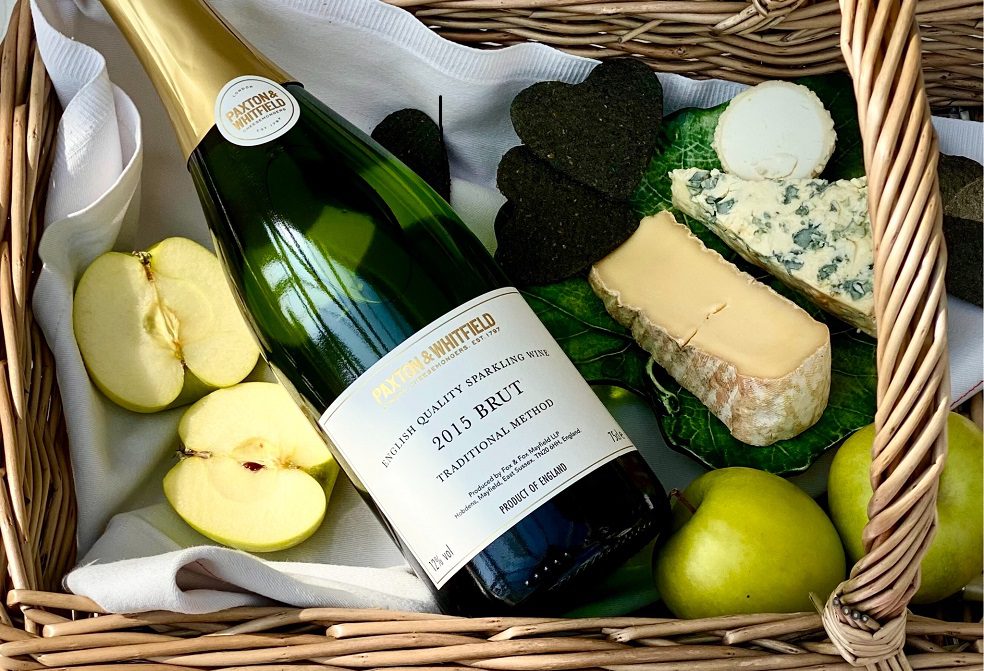
Commenting on the partnership with Paxton and Whitfield, Jonica Fox, co-founder of Fox & Fox, said: “As a boutique wine producer dedicated to quality over quantity, it is a true privileged to be working with Paxton & Whitfield who put as much consideration and care into sourcing and maturing their remarkable cheeses as we do growing our grapes. We hope that cheese lovers across the UK will enjoy the unique blend, and more importantly, will be able to appreciate a multitude of English wine and cheese pairings.”
“We are delighted to be working with the boutique English grower and award-winning producer Fox & Fox to bottle, for the first time ever, our very own, English sparkling wine,” said Suzanne Kennerley, Buying Manager at Paxton & Whitfield – the company which gained their first Royal Warrant to Queen Victoria in 1850 and today holds Royal Warrants of Appointment to Her Majesty The Queen and HRH The Prince of Wales.
“Our cheesemongers have selected this traditional method, sparkling wine for its versatile pairing with artisan cheese. It is a delightful ‘anytime’ English fizz. Light and effervescent, this wine has notes of gentle hawthorn, citrus, white peach, and freshly baked bread.”
Officially launched in stores and online at paxtonandwhitfield.co.uk for September 2021, the wine pairs well with a wide range of artisan cheese. Paxton particularly recommends it paired with the award-winning Golden Cross goats’ milk cheese, which is also produced in East Sussex. The acidity of both the wine and cheese are perfectly in balance, while the bubbles cut through the dense fudge-like texture of the cheese.
]]>Champagne Roger-Constant Lemaire won the title of The World’s Finest Glass of Bubbly 2020 with their Trianon 1966.
Guillaume is the grandson of Roger Constant Lemaire. He is continuing the family tradition of producing exceptional Champagne using modern and ecologically friendly techniques. Pictured here with his father, Gilles Tournant, also a talented winemaker.
Q: Is the job as a Champagne maker a 9 to 5 and a 5 day a week job? Early starts and late finishes?
No, it’s not a 9 to 5 and 5 day a week job. Generally I start at 8 am and finish at 6 pm from Monday to Friday and we receive clients for tasting and visits at the weekend as well.
There are special periods, like the harvest and bottling, etc… when I work a lot more, so my working hours are extended. The life of a winemaker is the same as a farmer.
Q: Do you ever taste other Champagne producer wines to explore the competition and their standards?
Yes of course, we frequently organize a “battle of bottles” at home with my winemaker friends.
Q: How important is family history / tradition / skills within Champagne making? How much of what you do today is what you learnt from your father?
It’s extremely important, because it’s a transmission of an important knowledge for generations, from father to son. I cannot just do anything, I have to respect the philosophy of my ancestors: namely the quality of the Champagne and an irreproachable reception. Methods and technology develop, but philosophy remains the same.
Q: Have there been many passionate arguments in the family when it comes to agreeing on the blend?
There’s been a significant progress in family discussions for 40 years. It’s exactly one of the aspects of a 100% family enterprise: every family member gives his/her opinion and waits to be heard. Let’s take the example of malolactic fermentation. Our grandfather, Roger Constant was in favor of this method and it was Gilles (his son-in-law) who proposed to stop to using the malo in order to obtain a better quality wine despite its difficulties.
Nowadays another subject that comes up is Bio. The older generation thinks that bio is ‘marketing’ and useless. On the other hand, the younger generation urges as much as possible to obtain the bio label.
Family debates are part of wine production and yes, we need to accept them… (Regarding the bio the younerg generation won that debate, we are in bio conversion.)
Q: Where are you most happiest? In your vineyards, in your cellars or in your production house?
I feel myself happy everywhere. In my vineyards I’m in the nature and it’s calm. But I’m especially happy in my production house, where I create my cuvees.
Q: If you weren’t a Champagne maker, what would you have been?
Oenologue, because you work in the world of wine as well. It’s a creative profession as well where we create wine for other winemakers.
]]>to the podium
March 2021: Ferrari Trento has been named the Official Sparkling Wine of Formula 1®. Announced globally ahead of the start to the 2021 FIA Formula 1® World Championship in Bahrain, the prestigious three year partnership will see Ferrari Trento’s award-winning sparkling wine become the official toast of Formula 1® celebrations throughout 2021, and beyond.
Formula 1® has appointed Ferrari Trento as its celebratory drink partner, not only because it is one of the most-awarded producers of sparkling wines but also in recognition of its long and respected history. Similar to Formula 1®, the Italian family-owned winery based in Trentino, in the Italian Alps, is a global leader in its field, crafting its luxury Trentodoc wines for over a century to become known as Italy’s sparkling wine par excellence.
With an incredible heritage in motorsport, Formula 1® has been pioneering in its field, with over half a billion passionate fans supporting the world’s best drivers and constructors, who have become household names and cultural icons. An emblem of the ‘Italian Art of Living’, Ferrari Trento has also been appreciated by distinguished guests at major international events for decades, with a Ferrari Trentodoc Jeroboam bottle even making an appearance on a Formula 1® podium in the past. However, this year’s return marks a special moment as Ferrari Trento introduces its world-class sparkling wine at all Formula 1® Grands Prix , stepping onto the podium to play a part in one of the most iconic moments in sport.
, stepping onto the podium to play a part in one of the most iconic moments in sport.
“We are very excited to announce this partnership with Formula 1® which is both an achievement and a starting point for us,” declared Ferrari Trento’s President and CEO, Matteo Lunelli. “It’s an achievement because it demonstrates the renown and the appeal that Ferrari Trento wines enjoy internationally, thanks to our team that works tirelessly across the board. It’s a starting point because we are just beginning this extraordinary adventure that will allow us to bring the Italian Art of Living to the celebrations of Formula 1®. We decided to embark on this project even in this complex time that the world is currently experiencing because we strongly believe in the future of Ferrari Trento.”
“This collaboration is based on shared values, such as the pursuit of excellence in every detail, innovation and passion. It is a great source of pride for us at Ferrari Trento and, I believe, a testament to the global appreciation of Italian excellence.” commented Simone Masè, General Manager of the Lunelli Group.
Stefano Domenicali, President and CEO, Formula 1®, said: “We are thrilled to announce Ferrari Trento as an official Partner of Formula 1® Celebrating success is in both our DNA and having Ferrari Trento at the heart of the sport’s most iconic celebratory moment makes them such a natural partner for us. For more than a century, Ferrari Trento has been synonymous with Italian excellency, pouring their passion into creating fine sparkling wines capable of elevating any moment, and we look forward to working together to create and enhance our fan experience on and off the podium“.
The 2021 FIA Formula 1® World Championship kicks off on 28th March with the Formula 1 Gulf Air Bahrain Grand Prix 2021 and a packed calendar of events planned across the year, where Ferrari Trento will be present to celebrate with racers and supporters throughout the entire season.
2021 and a packed calendar of events planned across the year, where Ferrari Trento will be present to celebrate with racers and supporters throughout the entire season.
For more information on Ferrari Trento please visit www.ferraritrento.com
]]>Italy’s luxury sparkling wine looks to start 2021 on a high, as celebratory drinks partner for the prestigious yachting team
The premium Italian winery, Ferrari Trento, joins the Luna Rossa Prada Pirelli Team in Auckland as its ‘Sparkling Partner’ for the 36th edition of the yachting world’s oldest and most prestigious competition, the America’s Cup.
An emblem of the ‘Italian Art of Living,’ Ferrari Trentodoc sparkling wines have accompanied the renowned Italian team at every stage of this top-level challenge since the very beginning. Ferrari Maximum Blanc de Blancs was the bottle broken by godmother Miuccia Prada over the bow of the first AC75 during the launch ceremony in October 2019. Since then, the team has continued to perform ‘to the maximum’ throughout the challenge, an objective shared with Ferrari Trento when it comes to reinforcing the values of excellence.
In October 2020, the team launched the second boat and recently took part in the PRADA America’s Cup World Series and PRADA Christmas Race, held in Auckland last month. Now, the team looks ahead to the PRADA Cup which will take place across January and February 2021, with Ferrari Trento supporting the team throughout. Kicking off on 15th January, the PRADA Cup is the challenger selection series which will determine the team competing in the final of the 36th America’s Cup presented by PRADA, taking place in March.
Ferrari Trento has been appreciated at major events of international renown for decades, and this partnership is no different, as the winery joins the team at some of the most prestigious events in the world of sport. A natural collaboration, the Luna Rossa Prada Pirelli Team and Ferrari Trento share many core values including those of excellence and Italian style. A group of outstanding professionals, the Luna Rossa Prada Pirelli Team not only bring technological merit to the competition, but also the passion and dynamism that have always been among the hallmarks of Italian excellence. Meanwhile, the northern Italian winery, owned by the Lunelli family, is also a global leader in its field, crafting its award-winning Trentodoc wines in the foothills of the Italian Alps for over a century, to become known as Italy’s sparkling wine par excellence.
]]>What’s on the plate:
Chicken Breast Crown
Roast Potatoes
Spicy Sprouts
Vegetable Medley
Yorkshire puds (shop bought)
Pork Chipolatas in blanket
Optional condiments – gravy
————————————————————————————————–
Ingredients for Spicy Sprouts
Half a regular sized pack of Brussel Sprouts – halved
1 x small red onion diced and fried
Salt
Ground Cumin
Chilli powder
A hint of tomato puree (optional) for colour/taste
Serves 3
——————————————–
Christmas 2020. It’s likely many of us are not doing what we would ‘normally’ do. When lockdown first hit in the Spring, I knew I’d not be going to the US as I had been for the last few years. What I have learnt over the last few years spending Christmas Day with my brother, cook a little bit more than you would normally but not too much, throw in some tradition but most importantly have what you enjoy.
I’m comfortable with my parents this year and we thought we’d put our Christmas memories on a plate and pair them with 2018 Camel Valley Pinot Noir Rosé Brut. As a British Indian, we’ve made the veg the central focus and spiced things up and light seasoning on everything else.
The Rosé
Lighter in colour than I was expecting. Initial standalone taste strawberry in flavour. A light fizz that makes for a great aperitif and easy drinking.
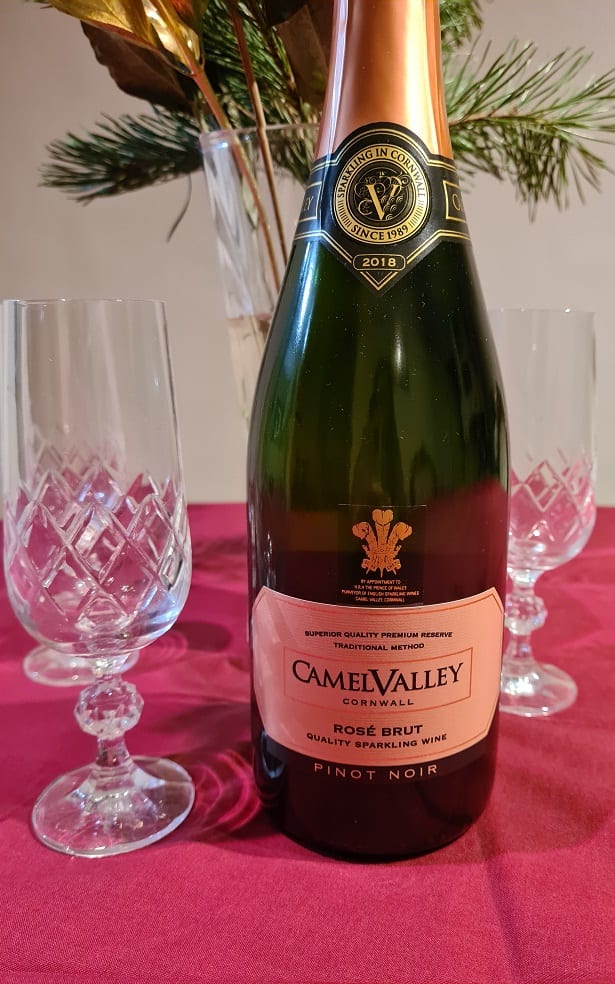
Chicken Breast Crown
I have to say picking the meat was actually the hardest part! I knew it would be chicken or salmon and went for the crown partly because it was just enough and skin on reminded me of Christmas Eve’s at my late German Aunt’s house.
Pairing verdict: The chicken was succulent and the wine stacked up well, with and without gravy.
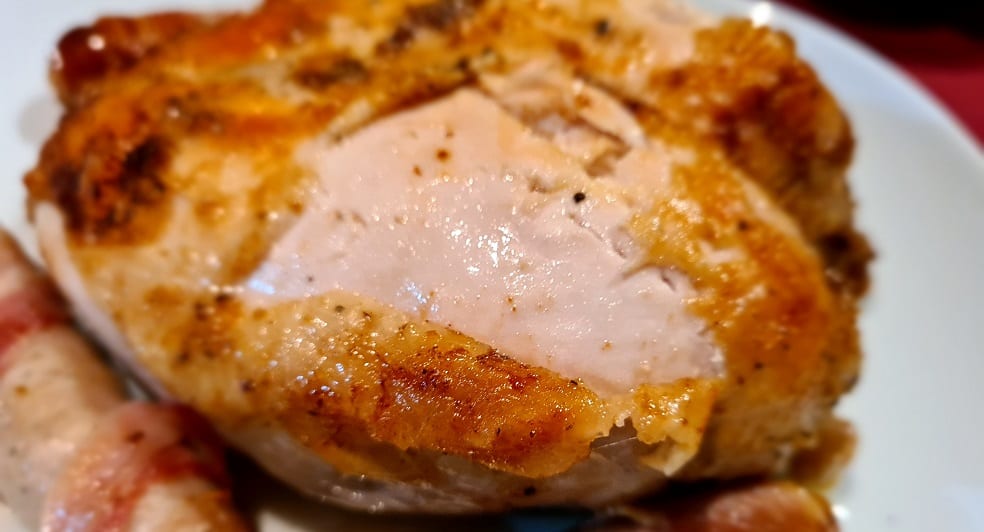
Chipolata
My father is a fan of pigs-in-blanket and thus this has become a given feature on our plates.
Pairing verdict: This paired perfectly with the wine. The colour complement may well have been an influence.

Spicy Sprouts
Love em or hate em, this is a given right? I think we’ve nailed our spicy sprouts recipe and actually have them other times of the year!
Pairing verdict: The sprouts, not the spice, completely overpowered the wine. The spice involved in this dish I’d suggest would work well with this wine however the flavour of the sprouts themselves cut through both.
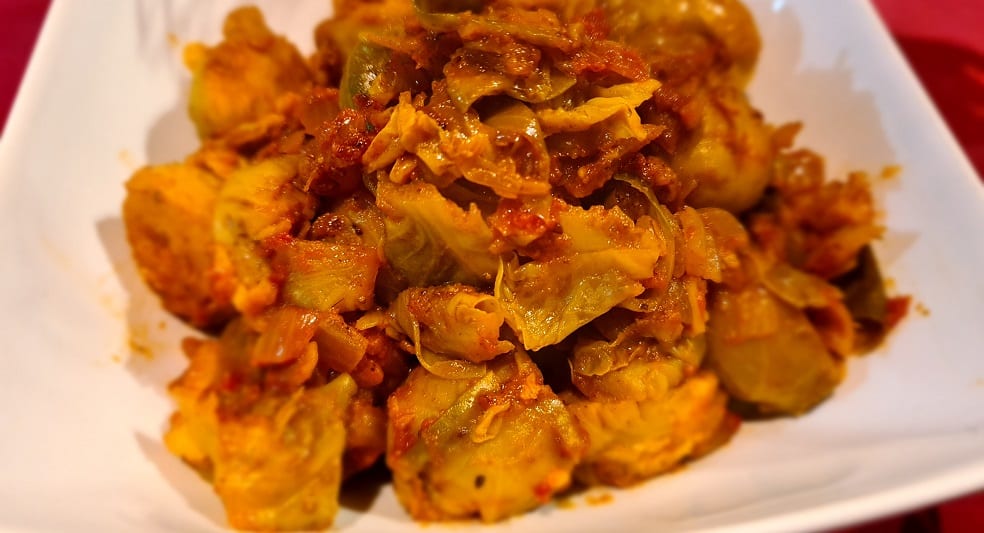
Variety Veg
One thing that is a given and probably more my brother’s influence is that there needs to be colour on the plate! Rather than lots of different individual veg with different flavours, a new addition this year we may keep! Using what we already had in and healthy – this ended up being a winner for all.
Pairing verdict: Excellent complement for each other – the subtle crunch of the red pepper and the carrots (that I’d never normally want to eat!) along with the 2 core spices lent to a sweet and sour taste that worked beautifully with this wine.
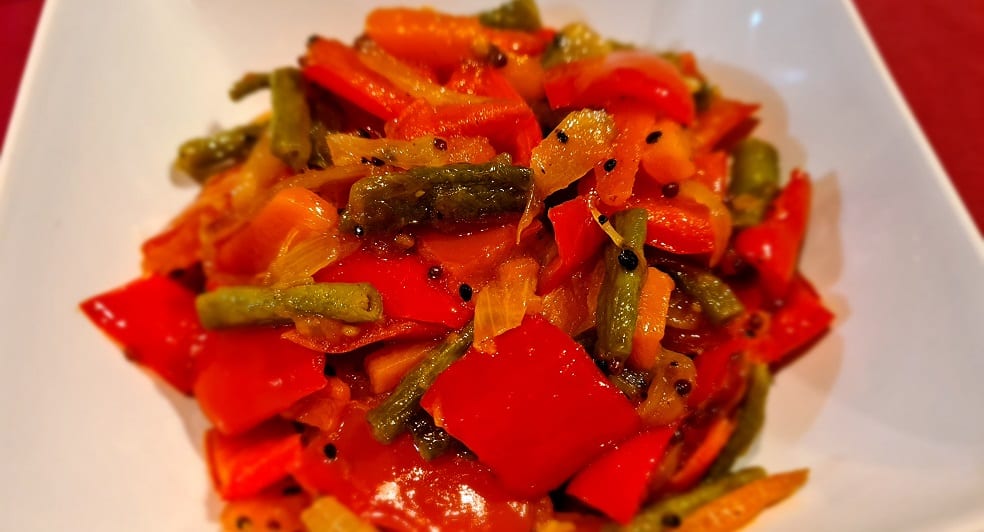
Roast Potatoes
Potatoes in any form are a staple for most Indians and roasties will always feature in this kind of meal. As much as I wanted a bit more seasoning wise, we kept it subtle given the veg on the plate.
Pairing verdict: Both items were light and fluffy and worked well on the palate.
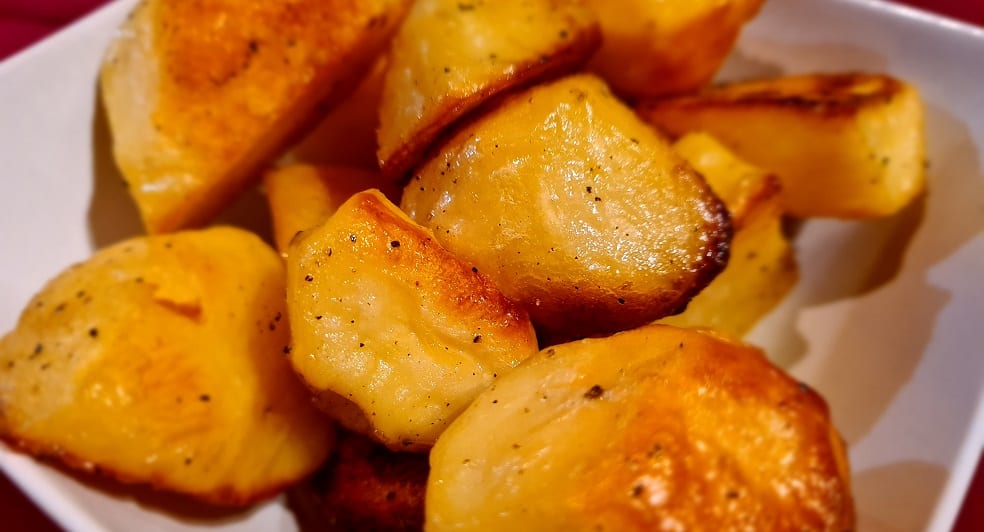
Yorkshire Puds
We definitely sit on the side of the fence that Yorkshires should be part of a Christmas Dinner so they were!
Pairing Notes: Unfortunately, these particular ones were a tad on the greasy side and the wine therefore almost acted as a palate cleanser.
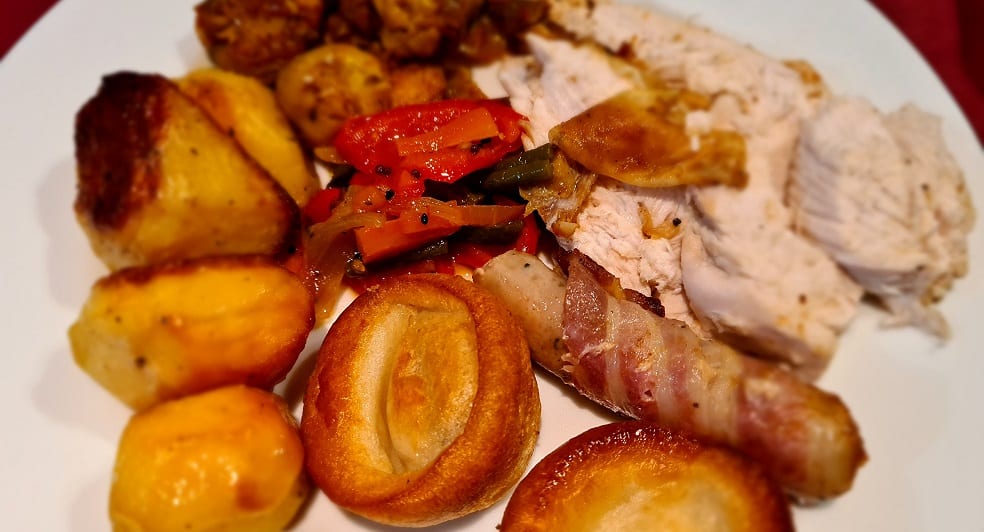
So there you have it, mixing traditional with innovation, nostalgia and the present and very little leftover. Whatever you decide for this Christmas and potential future roast dinners, have a happy holiday!
Author: Rupa Datta – [email protected]
]]>The Ratafia produced in Champagne would have been produced already in the 13th century and until these days, its production mainly serves a local market. The Ratafia Champenois was recognized in Protected Geographic Indication – PGI in 2015, being the zone of production, all the area delimited for Champagne. The Ratafia Champenois is sweet with a minimum of 110 grams of sugar per litre and alcohol that can range from 16-22% and aged at least 10 months in tanks or oak barrels. It is important to stress, that the sweetness comes from the natural sugar present in the grape must. At the time of pressing the grapes intended for the production of Champagne, the producer can allocate a part of the must, not exceeding 116 litres for each 4,000kg pressing for the production of Ratafia. The beverage is made with grapes that potentially can be used for the making of Champagne.
The Ratafia should be made within a maximum period of 20 days after the harvest. The alcohol used for the ‘mutage’, a process which consists of stopping the fermentation process with the addition of alcohol, will be sourced from local distilleries. The largest supplier of alcohol (Destillerie Goyard) from Ay, uses a column still, with the aim of creating relatively neutral alcohol, so that the characteristics of the grapes are highlighted keeping it very aromatic. Finally, a good Ratafia Champenois is best enjoyed at a low temperature of 4-6 degrees and can pair perfectly with fruit pies like apple pie, Tarte aux mirabelles (cherry plum) or stone fruits. It can be enjoyed at the end of the meal like a digestive.
Like any strong alcohol, Ratafia will keep for a long time once the bottle is open. In the past, it was common for bottles or barrels of Ratafia to be present aboard French merchant navy vessels due to their ability to preserve themselves, so don’t hesitate to keep it in your apartment or outside of a cellar, it will last. With the recognition in Geographical Indication, interest in Ratafia has grown and some producers start to release labels designed to offer quality Ratafias to a public outside the local market. The potential production of Ratafia is estimated at 17 million bottles per year.
Written by Luiz Batistello
]]>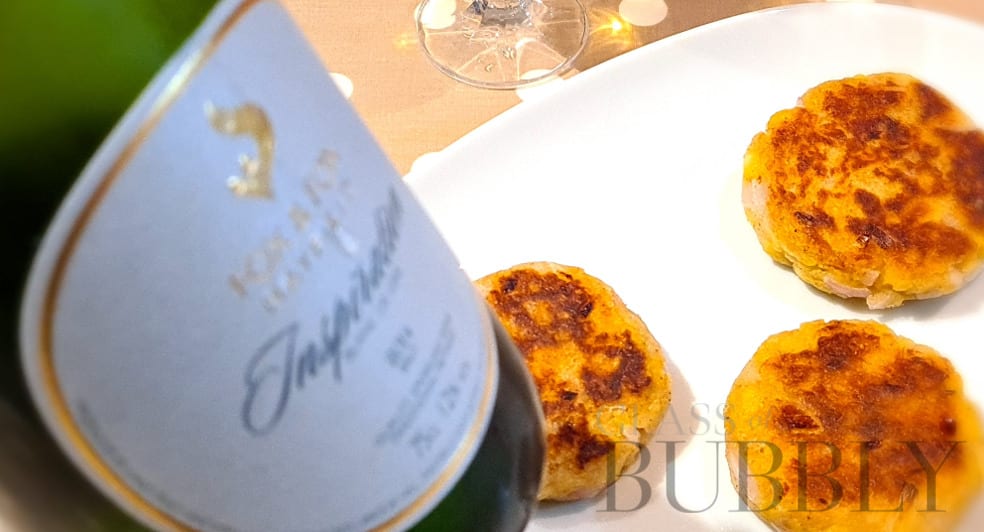
Green banana (Kaccha Kela)
Green banana (kaccha kela) and ginger cutlets
A staple that would largely be found in Southern India, we thought that this would be an ideal dish to pair with this wine – and it was! I later discovered that my paternal grandmother (Bengal) used to make a version of it that my father remembers fondly.
Tasting notes:
Light and yellow in colour with a notable ginger finish. The absence of a chutney as an accompaniment to it meant that after a couple of bites, it was dry in the middle. The wine came to the rescue as a result and the crunch of the onion added it’s own kick.
Verdict: Thumbs up for this pairing
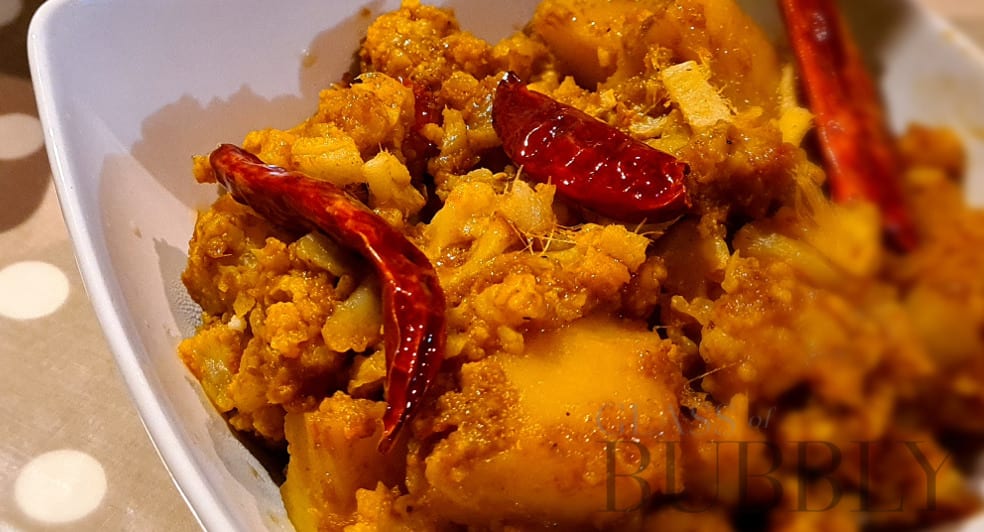
Aloo Gobi
Mains
Aloo Gobi (Potato and Cauliflower)
A Punjabi staple that was made famous in the UK during the early noughties because of a film named after a famous footballer! We often have this during Diwali as the ingredients are easy to put together and make in various quantities.
Tasting notes:
The dish had the right hint of spice. Succulent and soft in texture. The ginger finish once again sealed the complement though even without, the two would come together
Verdict: Thumbs up!
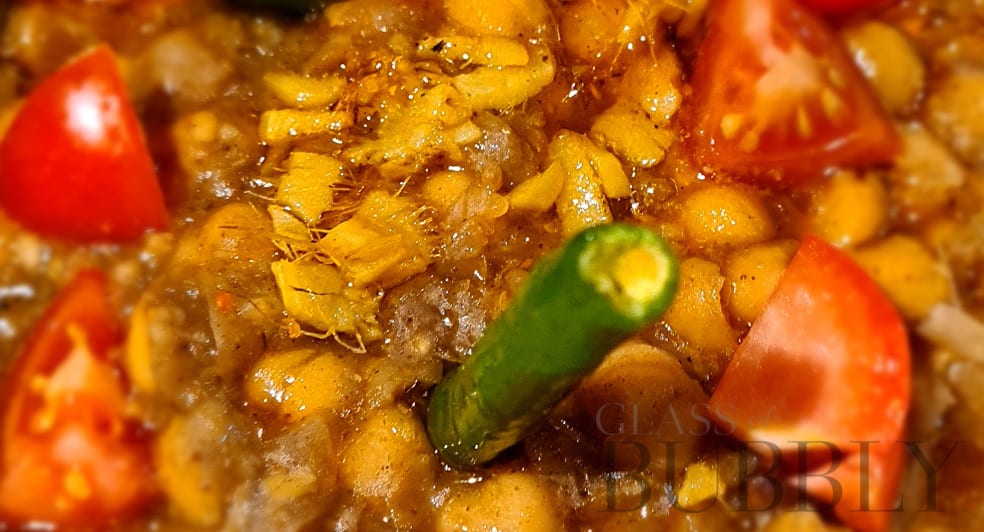
Punjabi Chole
Punjabi Chole (Chick pea curry)
Another traditional dish that often surfaces in our house around Diwali. Can be made for the masses. Normally left to rest for a day or so but the magic pressure cooker turned it around in no time.
Tasting notes:
Normally deep in flavour full of spice without being hot. The pairing worked with the mouthfuls that had the ginger garnish or tomato in it. Less so, more generally.
Verdict: This traditional Punjabi dish would work better with a glass of red rather than a sparking wine.

Puri – Flat Bread
Accompaniment – Puri (Fried flatbread)
A firm favourite in every household particularly for festive occasions. Paired beautifully with the wine and acted as a blanket against some of the harsher spice in the dishes.
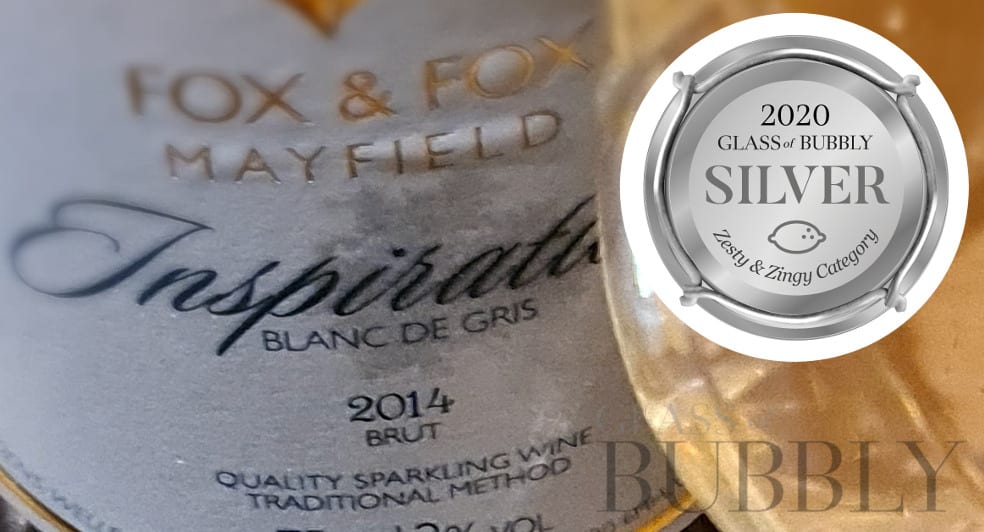
Inspiration Blanc de Gris 2014
Sparkling Wine Pairing:
Fox and Fox Inspiration Blanc de Gris Brut 2014
Recommended with spicier foods, particularly modern Indian. We decided to give it a go with a unique starter and more traditional Northern Indian mains that we would eat on Diwali.
Tasting / Pairing notes: Fresh and punchy aromas. Full of bold characters in flavours with attractive fruity (apple and pear) zestiness for the finish. Powerful enough to cut through most spicy style of dishes.
All in all, for a family of non-vegans it would be pretty easy for us to have a full vegan Diwali. When thinking about the menu, there were indeed times where we had to catch ourselves from making an accompaniment or a part of a dish with dairy in it, however, the evening was packed full of flavour and fizz as we would expect!
Author: Rupa Datta – [email protected]
]]>